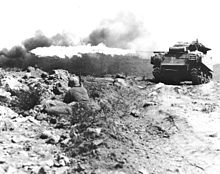Ronson (flamethrower)
The Ronson was a Canadian vehicle flamethrower of World War II .
The weapon was developed in 1941 by the British engineer Reginald P. Fraser on behalf of the Petroleum Warfare Department, founded the year before, and with the support of the Lagonda Company . It was installed in the Universal Carrier and reached a range of 40 yards (36 m), which the War Office found insufficient, so the project should be stopped. However, the Canadian armed forces , particularly General McNaughton , showed interest and continued to develop the weapon. “Ronson” was chosen as the name , probably an allusion to the lighter manufacturer of the same name .
Finally the flamethrower was ready for production at the end of 1942; the production took place exclusively in Canada. The weapon consisted of two fuel tanks with a capacity of 60 gallons (272 liters) attached to the rear of the carrier, carbon dioxide pressure bottles in the front of the vehicle as propellant and the flame thrower nozzle attached to the front, which was connected to the tanks by pipes (for reasons of space on the outside of the vehicle). The range was now given as 50 yards (46 m), which was still very little, but should be compensated for by the mobility. The tank capacity should be sufficient for about 40 short bursts of fire. A test unit was put together under the unofficial name Ronson Cavalry and demonstrated the weapon in the British test area Moody Down .
Although 1300 orders for the Ronson flamethrower were received, 300 of them for the Canadian Army, the planned series production failed and the Ronson Carriers were probably never used in combat. The reason for this was that RP Fraser had already developed his original Ronson design further and with the Wasp created a far superior flame throwing vehicle.
In the end, around 500 Ronson sets were produced. The British used the weapon in the experimental amphibious vehicle Dragonfly (a buoyant Ronson Carrier ) and Flammpanzer Churchill Oke , both were built only in minimal quantities. The main users were ultimately the armed forces of the United States : American engineers in Hawaii combined an improved Ronson with the M3A1 tank , creating the M3 Satan flame tank (24 units used by the Marine Corps in the Mariana Islands ). A modified replica of the Navy was the Navy Mark I flamethrower , which was used in the M4 Sherman (mainly used in Iwojima and Okinawa ) and the LVT-4 landing vehicle .
So the main importance of the Ronson was that it served as the base model for the development of advanced flamethrowers in both the UK and the US.
The derogatory British name Ronson for the Sherman tank has nothing to do with the flamethrower, but alluded (also in relation to the lighters) to its susceptibility to fire and the risk of explosion.
Individual evidence
- ^ Bryan Perrett, Ian V. Hogg: Encyclopedia of the Second World War , 1989, p. 350
- ^ John Alexander Swettenham: McNaughton (Volume 2), 1969, p. 170
- ^ Official History of the Canadian Army in the Second World War , p. 545
- ↑ David Fletcher: Churchill Crocodile Flamethrower , pp. 7/8
- ↑ Donald Avery: The science of war: Canadian scientists and allied military technology during the Second World War , p. 143
- ^ David Fletcher: The Universal Tank: British Armor in the Second World War , p. 57
- ^ Steven Zaloga : US Marine Corps Tanks of World War II , p. 20; Chris Bishop: The encyclopedia of weapons of World War II , pp. 269, 272
